List of Contents
Trauma Care Centers Market Size and Forecast 2025 to 2034
The global trauma care centers market size accounted for USD 17.42 billion in 2024 and is predicted to increase from USD 18.74 billion in 2025 to approximately USD 36.24 billion by 2034, expanding at a CAGR of 7.60% from 2025 to 2034. The growth of the market is attributed to the increasing incidence of road accidents, natural disasters, and violence-related injuries, requiring immediate and specialized medical attention.
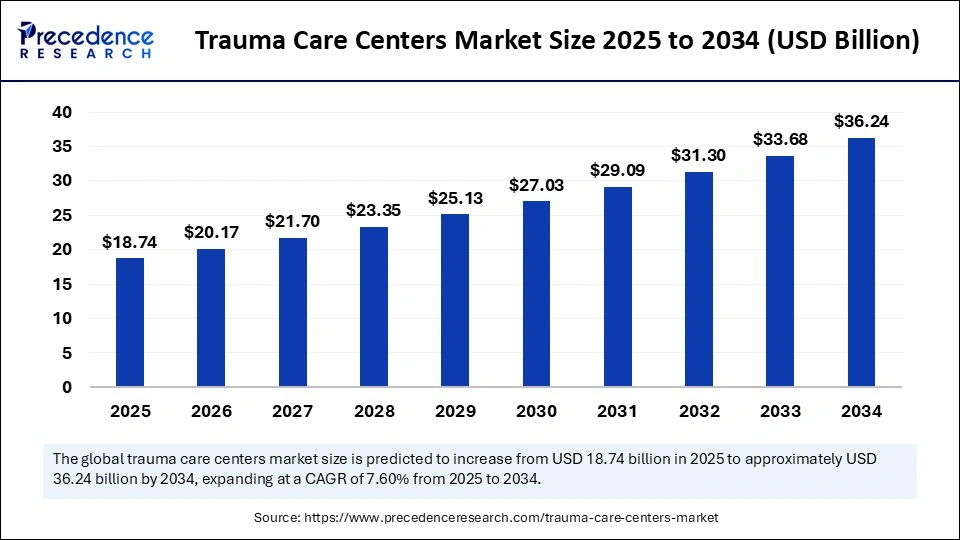
Trauma Care Centers Market Key Takeaways
- In terms of revenue, the trauma care centers market is valued at $18.74 billion in 2025.
- It is projected to reach $36.24 billion by 2034.
- The market is expected to grow at a CAGR of 7.60% from 2025 to 2034.
- North America held the largest market share of 55% in 2024.
- Asia Pacific is expected to grow at a notable CAGR of 9% during the forecast period.
- By facility type, the in-house segment contributed the highest market share of 74% in 2024.
- By facility type, the standalone segment is expected to witness significant growth in the upcoming period.
- By trauma type, the falls segment accounted for the largest market share of 45% in 2024.
- By trauma type, the traffic-related injuries segment is projected to grow at the fastest rate during the forecast period.
- By service type, the outpatient segment generated the major market share of 66% in 2024.
- By service type, the inpatient segment is anticipated to expand at the highest CAGR in the coming years.
How is AI Transforming Emergency Triage and Patient Care in Trauma Centers?
Evidence-based decision-making is made possible by intelligent systems like Artificial Intelligence, which are transforming emergency triage. AI tools improve clinical judgment and guarantee that high-risk individuals receive prompt attention by processing real-time data, including vital signs, injury scores, and electronic health records. In high-volume settings, AI expedites workflows, which eventually lowers treatment delays and improves patient outcomes in hectic trauma settings. Digital triage solutions emerge as strategic assets for trauma centers from an operational perspective. They minimize crowding, avoid resource misallocation, and maximize staff deployment by precisely classifying patients according to severity. In addition to improving care delivery, institutions that embrace this shift are also becoming more cost-efficient and strengthening their standing as emergency medicine leaders. AI supports decision-making by analyzing patient data to predict outcomes and recommend optimal treatment plans.
U.S. Trauma Care Centers Market Size and Growth 2025 to 2034
The U.S. trauma care centers market size was exhibited at USD 8.81 billion in 2024 and is projected to be worth around USD 18.60 billion by 2034, growing at a CAGR of 5.23% from 2025 to 2034.
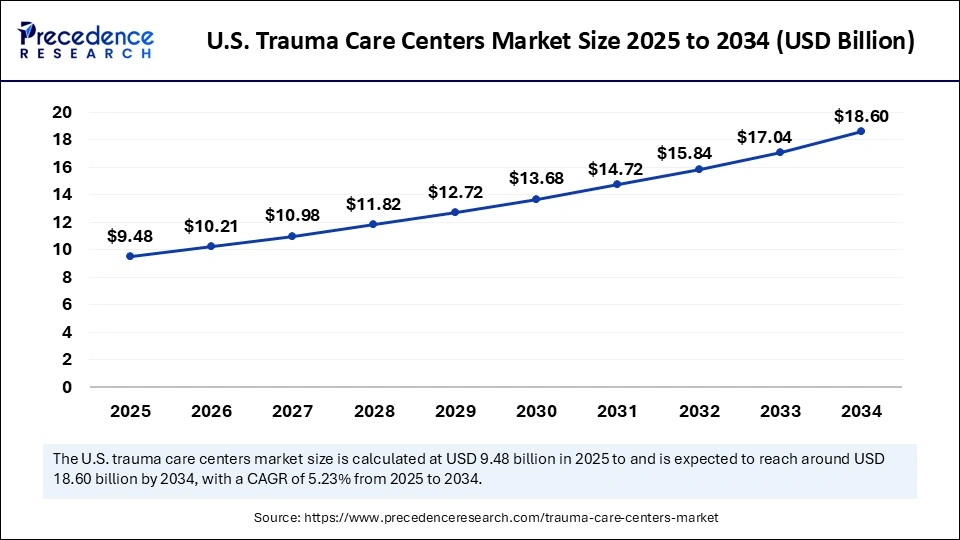
North America dominated the trauma care centers market by holding more than 55% of market share in 2024. This is mainly due to a high number of trauma cases and a well-established healthcare system. A robust network of cutting-edge trauma centers and skilled medical personnel bolstered the growth of the market. North America's dominant position in this market is further reinforced by consistent government funding for emergency response systems and technological developments in trauma care.
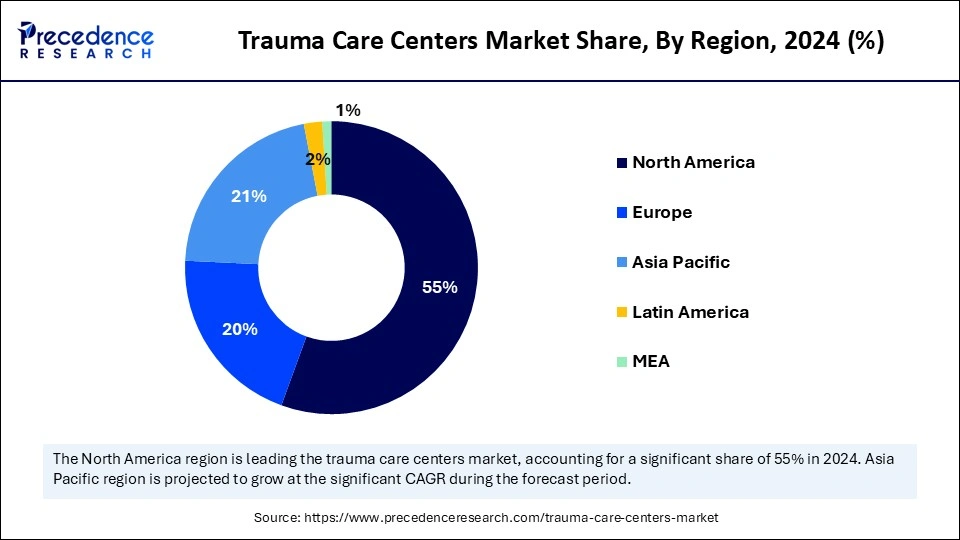
Asia Pacific is expected to witness the fastest growth in the upcoming years, owing to the growing number of cases of traffic accidents and increasing awareness of emergency medical care. The establishment of trauma centers is being aided by growing public and private sector investments as well as expanding healthcare infrastructure in emerging nations like China, India, and those in Southeast Asia. Advancements in trauma response systems and ambulance services, which are improving access to prompt care, are also driving the growth of the market in the region.
Europe is considered to be a significantly growing area. The growth of the trauma care centers market in the region can be attributed to the rising incidence of traumatic injuries. Strong regulatory frameworks, excellent clinical care standards, and broad access to medical care further support regional market growth. The region is still committed to integrating multidisciplinary treatment approaches and modernizing trauma care facilities. Governments and healthcare organizations are working together to improve outcomes and streamline trauma response systems, which further influence the market in Europe.
Market Overview
The trauma care centers market is witnessing rapid growth, driven by the rise in traumatic injuries from incidents involving violence, falls, workplace dangers, and auto accidents. Healthcare systems are investing more in specialized infrastructure and skilled staff to effectively handle emergencies as a result of growing awareness of the value of early intervention in trauma cases. As hospitals strive to lower mortality rates and enhance post-injury outcomes, there is a growing need for structured multispecialty trauma centers.
Trauma care facilities are becoming even more capable thanks to technological developments in critical care monitoring, surgery, and diagnostic imaging. Decision-making in emergencies has become faster and more accurate thanks to the integration of AI, robotic-assisted surgery, and real-time data analytics. Furthermore, in both urban and underserved areas, governments and private healthcare providers are working together to improve access to specialized services, build trauma care networks, and fortify emergency response systems.
Trauma Care Centers Market Growth Factors
- The rising incidence of traumatic injuries, including road accidents, falls, and violence, increases the demand for emergency care services
- Expansion of emergency medical services (EMS), especially in rural or underserved areas, contributes to market growth. These services improve patient access to trauma centers.
- The rising government support and funding for developing trauma centers to reduce injury-related mortality boosts the growth of the market.
- Growing awareness about timely trauma care among the public and healthcare professionals drives the growth of the trauma care centers market.
- The increasing prevalence of chronic conditions further supports market growth. This elevates the risk of complications from minor trauma, necessitating specialized care.
Market Scope
| Report Coverage | Details |
| Market Size by 2034 | USD 36.24 Billion |
| Market Size in 2025 | USD 18.74 Billion |
| Market Size in 2024 | USD 17.42 Billion |
| Market Growth Rate from 2025 to 2034 | CAGR of 7.60% |
| Dominating Region | North America |
| Fastest Growing Region | Asia Pacific |
| Base Year | 2024 |
| Forecast Period | 2025 to 2034 |
| Segments Covered | Facility Type, Trauma Type, Service Type and Region |
| Regions Covered | North America, Europe, Asia-Pacific, Latin America, and Middle East & Africa |
Market Dynamics
Drivers
Rise in Smart City Projects with Built-in Emergency Health Hubs
Trauma care facilities are being incorporated into urban health planning as a result of the government's push for smart city infrastructure. With the rise in smart city projects, governments are focusing on trauma centers that focus on specific types of traumas, such as brain injuries or burn injuries. Rapid response teams' digital emergency systems and pre-hospital trauma support are frequently included in these initiatives. In city clusters, the proximity of care facilities guarantees prompt treatment during prime time. These integrated hubs boost the resilience of the health system and lower mortality rates as urban populations increase, propelling market expansion.
Telemedicine Integration in Trauma Triage
The integration of telemedicine in trauma care drives the growth of the trauma care centers market. As tele-trauma consultations become more popular, trauma care is moving beyond physical centers. To stabilize patients while they are in transit, emergency responders and remote care facilities are now using AI triage systems and video diagnostics. This has improved trauma services accessibility and effectiveness in rural and underprivileged areas. Real-time access to specialists also enhances decision-making and results during crucial early interventions.
Specialized Pediatric and Geriatric Trauma Units
Specialized trauma care for vulnerable age groups, such as children and the elderly, is becoming more and more important. These groups need specific treatment plans and facilities, like fall prevention devices and age-appropriate diagnostics. To address these needs, specialized units are being established in trauma centers and tertiary hospitals. The market is growing due to the demand for age-specific trauma services.
Restraints
Shortage of Skilled Trauma Specialists
A shortage of skilled trauma specialists is expected to hinder the growth of the trauma care centers market. Finding trained trauma nurses, physicians, and support staff remains a challenge, particularly in tier-II and rural areas. This, in turn, reduces the capabilities of trauma centers. These specialists require years of training. Patient care is delayed, and survival rates are decreased in areas with limited resources due to this skill gap. Networks for trauma care are still unable to expand due to a lack of workers.
Delayed Emergency Response in Remote Areas
Lack of ambulance services and inadequate road infrastructure have a significant impact on trauma response times in rural and isolated areas. Survival rates are decreased when patients are transported to trauma centers or arrive late, particularly during the golden hour. These logistical and geographic obstacles reduce the efficacy of trauma care in non-urban areas. Additionally, it draws attention to unequal market penetration in developing nations.
Opportunities
Development of Mobile Trauma Units and Air Ambulance Services
Rising development of mobile trauma units and air ambulance services create immense opportunities in the trauma care centers market. For emergency care in remote locations, air ambulances and mobile trauma vans offer a scalable solution. These units can be quickly deployed in the event of a traffic accident, natural disaster, or mass casualty incident. Additionally, they provide initial care during emergencies, particularly in situations without fixed facilities. Rising investments in mobile trauma systems creates new sources of income.
Focus on Pediatric and Sports-Related Trauma
Specialized trauma services such as orthopedic trauma units and concussion care are becoming more and more in demand among athletes and kids. Younger populations are experiencing higher injury rates as a result of increased involvement in sports and leisure activities. By providing specialized services, rehabilitation, and prevention initiatives, hospitals can capitalize on this market. Additionally, in a cutthroat healthcare market, this specialization enables differentiation.
Facility Type Insights
The in-house segment dominated the market with the largest share of 74% in 2024. This is mainly due to the widespread integration of trauma units within well-known hospitals and medical facilities, which guarantees prompt access to cutting-edge diagnostics, surgical capabilities, and specialized teams. Both patients and healthcare providers favor the in-house model because it improves patient outcomes through easier coordination and resource availability. Furthermore, the fact that existing hospital infrastructure reduces operating costs increases patient volumes in in-house facilities, bolstering segmental growth.
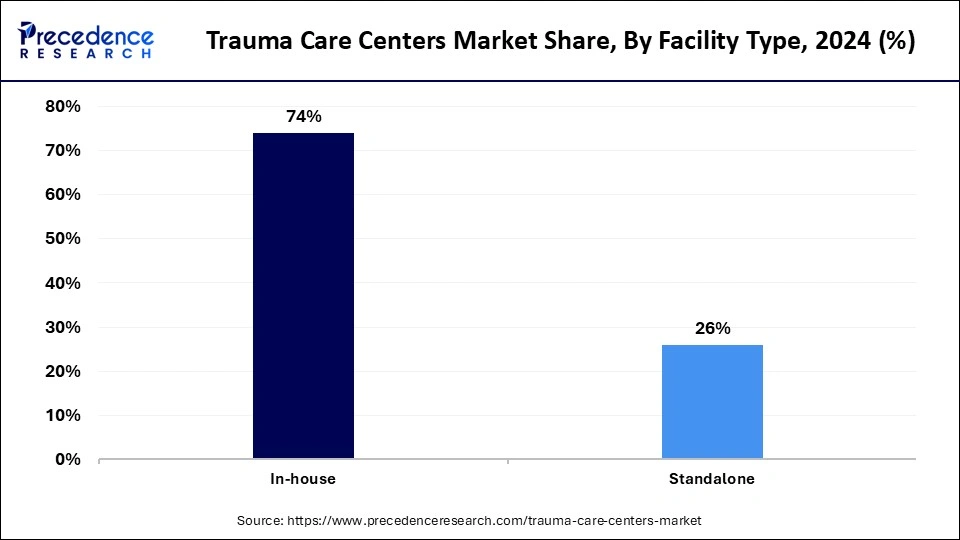
The standalone segment is expected to witness significant growth in the upcoming period. The growth of the segment is attributed to the rising investments in specialized healthcare infrastructure as well as the rising demand for trauma-focused facilities that provide focused care and quicker admission. In addition to being ideally situated to serve high-incident areas, standalone trauma centers frequently implement cutting-edge technologies that speed up emergency response time. The rising focus on decentralizing emergency services to increase accessibility and lessen hospital burden further contributes to the growth of the segment.
Trauma Type Insights
The falls segment held the biggest market share of 45% in 2024 due to the high rate of injuries caused by falls in all age groups, particularly in the elderly. As the population ages, healthcare facilities are experiencing an increase in fall-related trauma cases, including head injuries and fractures. The frequency of long-term illnesses such as osteoporosis increases the likelihood and severity of fall-related injuries, which creates the need for trauma care services.
The traffic-related injuries segment is projected to grow at the fastest rate during the forecast period. Specialized trauma interventions are in high demand due to the rise in traffic accidents, especially in urban and densely populated areas. Inadequate road safety measures, distracted driving, and rising car ownership are some of the factors causing this upward trend. Additionally, advancements in trauma response systems and emergency medical services are making it possible for more accident victims to get access to trauma centers promptly, supporting the growth of the segment.
Service Type Insights
The outpatient segment accounted for the highest market share of 66% in 2024 due to the fact that it is less expensive, takes less time to recover, and people prefer less invasive procedures. Many trauma cases can be successfully handled in outpatient settings without the need for hospitalization, especially those involving minor injuries and follow-up care. Improvements in diagnostic and treatment technologies have enabled healthcare providers to provide high-quality care on an outpatient basis. Outpatient services are preferred for patients and healthcare systems since they lessen the strain on hospital infrastructure.
The inpatient segment is anticipated to expand at the highest CAGR in the coming years, driven by the increase in cases of severe and complicated trauma that necessitate extended hospital stays and critical care. Inpatient services that provide 24-hour monitoring, surgery, and rehabilitation are becoming more and more necessary as the number of trauma cases involving high-impact injuries, multiple fractures, and traumatic brain injuries rises. The expansion of hospitals' critical care beds and trauma-designated units, particularly in areas with growing populations and increasing accident rates, is likely to support segmental growth.
Trauma Care Centers Market Companies
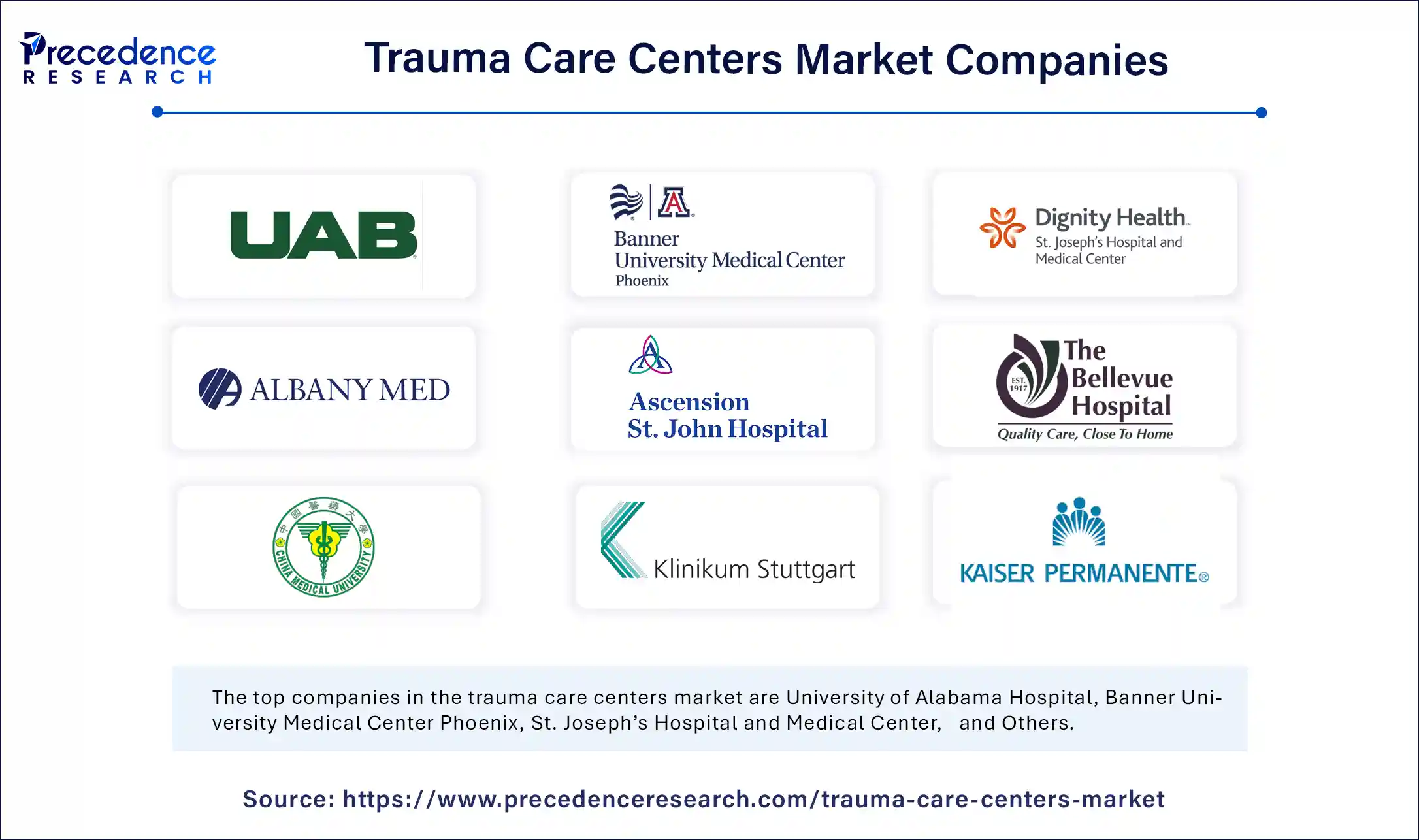
- University of Alabama Hospital
- Banner University Medical Center Phoenix
- St. Joseph's Hospital and Medical Center
- Albany Medical Center
- Ascension St. John Hospital
- Bellevue Hospital Center
- China Medical University Hospital
- Klinikum Stuttgart
- Kaiser Permanente
- University Hospital Southampton NHS Foundation Trust
Latest Announcement
- In February 2025, SCB Medical College and Hospital, Cuttack, received approval from the Odisha government to establish a 500-bed trauma care center under the PMSSY scheme. The project aims to boost critical care infrastructure for accident victims. Chief Minister Mohan Charan Majhi stated, “This is a crucial step in strengthening our healthcare system for timely trauma response.”(Source timesofindia.indiatimes.com)
Recent Developments
- In May 2025, Odisha's chief minister inaugurated trauma care services at Dharanidhar Medical College and Hospital in Keonjhar. This initiative is part of a broader plan to establish trauma care units in medical colleges across all mining districts, aiming to enhance healthcare infrastructure and accessibility. (Sourcetimesofindia.indiatimes.com)
- In July 2024, ADP India partnered with the department of health to construct its trauma care center at the Korlapahad toll plaza in Kethepally Mandal, Nalgonda district. The primary purpose of this trauma care center is to deliver immediate and effective medical treatment to accident victims, significantly reducing the time between injury and care. (Source https://www.expresshealthcare.in)
Segments Covered in the Report
By Facility Type
- In-house
- Standalone
By Trauma Type
- Falls
- Traffic-related Injuries
- Stab/Wound/Cut
- Burn Injury
- Brain Injury
- Other Injuries
By Service Type
- Inpatient
- Outpatient
- Rehabilitation
By Region
- North America
- Europe
- Asia Pacific
- Latin America
- Middle East & Africa
For inquiries regarding discounts, bulk purchases, or customization requests, please contact us at sales@precedenceresearch.com
Frequently Asked Questions
Ask For Sample
No cookie-cutter, only authentic analysis – take the 1st step to become a Precedence Research client